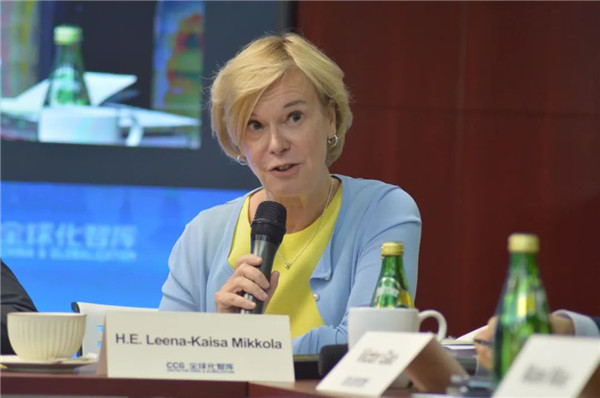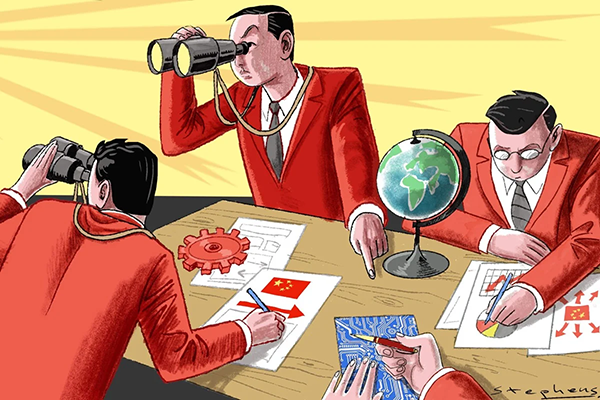H.E. Leena-Kaisa Mikkola Speaks at CCG Ambassadors’ Roundtable
July 10 , 2023In an era of globalization, countries everywhere face daunting socioeconomic challenges. Inequality is rising. Cohesion is weakening as societies undergo identity crises. As governments in search of role models for governance, equality, and social and economic policy, the so-called Nordic model often ranks the top. Practiced in Nordic countries, including Sweden, Norway, Denmark, Finland, and Iceland, the Nordic model is characterized by a state welfare system, access to quality education, and low income disparities, which contributes to the countries’ continued growth and prosperity.
China shares the Nordic countries’ drive to combine market economy and government intervention. As the country seeks to transform its economy and address challenges due to unfettered growth in the past decades, the Nordic experiences may shed light on possible pathways toward the national goal of common prosperity. This event provides highly contextualized accounts of the Nordic model and a discussion about its relevant applications for the future.
At the Center for China and Globalization (CCG) the Ambassadors of the five Nordic countries, Denmark, Finland, Iceland, Norway and Sweden presented different aspects of Nordic governance and practices, including fiscal policy, education, parental leaves, demographic policy, resource management and sustainability, and exchanged views with Chinese scholars and officials on how China can learn and build on Nordic experiences and practices as it works to meet its national goal of common prosperity.
Presentation by H.E. Leena-Kaisa Mikkola, Ambassador of Finland to China

I will talk shortly about Finnish education system, and in particular about educational equality. I will concentrate on the Finnish system, but the issue of equality is very important for all of us in every country’s educational system.
During the last years, my country has often been in the headlines when it comes to quality education. According to many international surveys and studies, we have indeed done quite well in improving equal and quality education for all. But before highlighting the aspects of educational equality, let me start with a few words about historical background and the Finnish educational system in general. I will also address the issue of vocational education, which I think is essential when building the society for all, a society of equal opportunities.
It is perhaps of interest for you to know that Finland was among the last countries in Europe to make education compulsory. We became independent from centuries of Swedish and Russian rule in 1917, and the act concerning general compulsory education came into force in 1921. Schooling was common even before that, especially in the urban areas. However, in the countryside, where majority of Finns those days lived, schooling of children was less common. And this also relates to my own family background, my grandmother was born in a village in 1906 and she never went to school. The act from 1921 aimed to do away with the educational inequality between towns and countryside, and the idea of educational equality has remained one of the guiding principles in our education system ever since.
Equality consists of two dimensions – fairness and inclusion. Fairness means reducing the social-economic barriers, while inclusion is to ensure basic standards of education to all. We don’t live in a perfect world and it would be hypocritical to claim that we, or somebody else, has achieved complete equality through education. But while not perfect, I would say that Finland and other Nordic countries have done quite well. Finnish youth have universal and free access to education. Students’ gender or school’s language of instructions explains a very small part of the difference in skills during his or her educational path. Whether the student comes from the capital area or from the sparsely populated northern part of the country doesn’t make a real difference when evaluating skills, or academic achievements.
The successes that we have had didn’t happen overnight 102 years ago. It has taken many decades to achieve. There has been a series of reforms and responses also to changing economic needs. But through trial and error, Finland has built successes in education. Of course, broader societal factors have also been helpful. The overall commitment to equality, various welfare services, and the question of strong cultural trust have always been fundamental when developing our road. There has always been a kind of whole society approach, but what works for us, might not always be 100% copy pasted for others.
However, there are some ideas free for copying.
Firstly, education for all approach has been a hallmark for Finnish education policy since its onset. There has always been and there still is a broad political consensus to build public school system that will serve every student without costs. As a result, every Finn has subjective right to participate in quality schooling, cost free from early childhood education, all the way to obtaining a university diploma. The equality aspect is supported by investments, for example, in free school meals, free school rides, but also in investing in special education. The Finnish education system is in many ways very flexible. We know that students’ and pupils’ preferences change as they grow older. Education also needs to be able to respond to the fast-paced changes taking place in the labor market and the society. To allow for the necessary flexibility, there are no dead ends in our education system. A student entering and graduating a vocational school, for example, is still able to pursue later on a university level education. In recent years, efforts have been made to increase possibilities of personalizing studies, also already at the secondary education level, something that has been very much the case at the tertiary level of education.
Coming back to the culture of trust. At the primary and secondary level there are no ranking lists compiled of Finnish schools. The most important thing is the system of trust based on the qualified and committed educational staff. Educational policy development is to a large degree headed by professional educationalists, rather than politicians. Teaching is a sought-after career that people respect. Entry into that profession is quite hard – often only one out of 10 applicants is accepted into teachers’ training programs in the universities. But high standard of staff means also greater independence. The schools are able to supplement the national curriculum with locally important topics and independently decide how the teaching is carried out.
Now a couple more words about vocational education and why. We think good quality vocational education is not only about equality in education, but also about equal opportunities in the society as a whole. The development of Finland’s vocational education system has parts in our history. After the Second World War, Finland had to pay huge reparations to the Soviet Union, which were basically paid in goods, machinery, and ships, which we didn’t have. In order to have all these, we needed to significantly adjust our industrial production, which meant we needed a significant amount of skilled and qualified workers. That was the stepping-stone for our vocational education schools and appreciation of them. Nowadays, it takes about three years to get a vocational education degree. The training is to provide the necessary skills for working life. But not only that, the education also supports students’ growth as individuals and responsible members of the society. It is characteristic to the Finnish system that about half of the students choose vocational education as their secondary education.
To conclude, we Finns are quite pragmatic and levelheaded people. We are equally levelheaded and realistic about the challenges and problems facing our educational system. The picture is not always rosy and one must admit that in recent years, regional differences in educational inequality have grown. Also, the differences in the skills of students in different schools have grown somewhat. However, from an international perspective, the differences between schools and students are still quite moderate in Finland. When we see inequality, we take it very seriously, because it mirrors very much the equality in the society as a whole and also the social cohesion that makes us the happiest country in the world for the sixth time, which we value so much.
On a personal note, which explains educational thinking in Finland: during my previous postings, an educational expert from that country asked my older son, who was 15 at the time, what is the difference between the international school he attended at the time and the Finnish school he attended previously. My son explained that in this international school, we prepare for academic excellence, but in my Finnish school, we prepared for life.
Topical News See more







